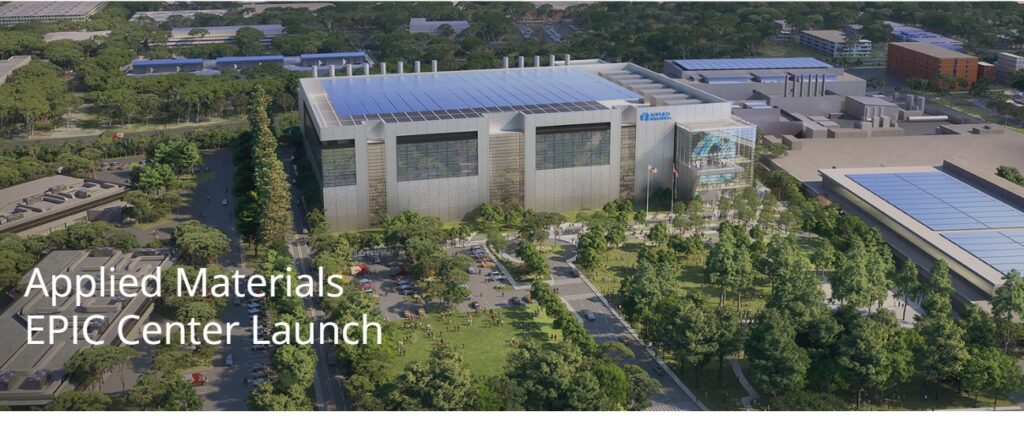ASIA ELECTRONICS INDUSTRYYOUR WINDOW TO SMART MANUFACTURING
Applied Materials’ EPIC R&D Platform to Accelerate IC Innovation
Applied Materials, Inc. announced a landmark investment to build the world’s largest and most advanced facility for collaborative semiconductor process technology and manufacturing equipment research and development (R&D). The company plans to put the new Equipment and Process Innovation and Commercialization (EPIC) Center at the heart of a high-velocity innovation platform. Specifically, it is designed to accelerate development and commercialization of the foundational technologies needed by the global semiconductor and computing industries.

The multibillion-dollar facility will be located at an Applied campus in Silicon Valley. It is designed to provide a breadth and scale of capabilities unique to the industry. This includes more than 180,000 square feet – more than three American football fields. Also integrated is a state-of-the-art cleanroom for collaborative innovation with chipmakers, universities, and ecosystem partners.
Most especially, the new EPIC Center is designed from the ground up to accelerate the pace of introducing new manufacturing innovations. It is aimed to reduce the time it takes the industry to bring a technology from concept to commercialization by several years. Meanwhile, it is also seen to simultaneously increase the commercial success rate of new innovations and the return on R&D investments for the entire semiconductor ecosystem.
“While semiconductors are more critical to the global economy than ever before, the technology challenges our industry faces are becoming more complex,” said Gary Dickerson, President and CEO of Applied Materials. “This investment presents a golden opportunity to re-engineer the way the global industry collaborates to deliver the foundational semiconductor process and manufacturing technologies needed to sustain rapid improvements in energy-efficient, high-performance computing.”
Addressing Industry Challenges
The tremendous growth in the number of connected devices and the rise of artificial intelligence are driving increasing demand for chips and the opportunity for a $1 trillion semiconductor market. At the same time, chipmakers face significant challenges to sustain the pace of innovation required to meet this demand.
The “angstrom era” of chipmaking requires new foundational manufacturing technologies that are orders of magnitude more complex than those used today. This increased complexity drives higher R&D and manufacturing costs, while lengthening the time it takes to develop and commercialize new semiconductor technology through high-volume manufacturing. Further hurdles include a critical shortage of technical talent needed by the industry and the pressing need to reduce the carbon intensity of the electronics industry.
Accelerating Chipmaker Roadmaps
For decades, chipmakers have relied on rapid advances in foundational semiconductor technology to deliver continued improvements in chip performance, power, area, cost and time-to-market (PPACt). Billions of dollars are invested each year to drive new inflections in the way chipmakers create, shape, modify, analyze, and connect materials and structures at the atomic scale. Once developed, these technologies must be proven to work reliably and cost-effectively in industrial-scale equipment for high-volume manufacturing.
While these technology inflections continue to drive the industry forward, the sheer complexity of the engineering challenges requires a new approach to R&D. The traditional development model, starting with materials engineering equipment and process innovation, is a serial, compartmentalized process with no central hub for collaboration across the ecosystem. The industry needs a new model that breaks down traditional silos, builds denser networks of collaboration, and delivers tighter feedback loops that can increase the speed and lower the cost of innovation.
Applied’s new EPIC Center is designed to be a premier platform for leading logic and memory chipmakers to collaborate with the equipment ecosystem. For the first time, chipmakers can have their own dedicated space within an equipment supplier facility. They can extend their in-house pilot lines and providing early access to next-generation technologies and tools – months or even years before equivalent capabilities can be installed at their facilities.
A number of leading semiconductor and computing companies, including AMD, IBM, Intel, Micron, Nvidia, Samsung, TSMC and Western Digital, have commented on today’s announcement. The videos are available here.
Strengthening University Pipelines
The platform is also expected to be a catalyst for accelerating the commercialization of academic research and strengthening the pipeline of future semiconductor industry talent.
Universities are uniquely skilled at ideating new concepts, but they often lack access to state-of-the-art industrial labs and hardware, which can impede their ability to turn ideas into commercial reality. Applied’s new platform can provide university researchers access to the full range of industrial-scale capabilities to validate their ideas; thus, increasing the success rate of innovations and reducing the time and cost of commercializing new technologies.
This would be achieved with a two-pronged approach. University researchers can perform research alongside industry professionals in the new EPIC Center. Meanwhile, Applied can collaborate with academic partners to build a network of industrial-quality satellite labs at university facilities. The new approach is designed to build upon Applied’s existing relationships with top engineering schools, such as Arizona State University, where Applied has been conducting research in materials science and semiconductor technology alongside faculty and students.
“We’re all-in as an asset to industry and to the nation as we seek to regain global pre-eminence in semiconductor manufacturing, research and development,” said ASU President Michael Crow. “Applied Materials is providing extraordinary leadership to accelerate innovation and commercialization of foundational manufacturing technologies that will define the future of how chips are made. And as we continue to innovate in that process, ASU will bring research expertise and help create the future innovation and manufacturing talent pipeline that will be critical over the long term.”
Video comments from leading universities, including Arizona State University, Massachusetts Institute of Technology, the State University of New York, University of California, Berkeley and the University of Texas at Austin, are available here.




